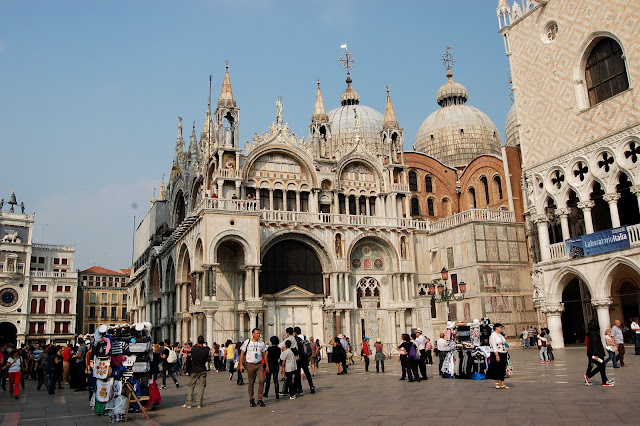Arriving at the center of the bridge on the right is the famous Ponte dei Sospiri or Bridge of Sighs. (Click on picture to enlarge.)
This enclosed bridge, from the 17th century, is made of limestone and connects the old prisons to the Doge's Palace Interrogation Room. Lord Byron named it the Bridge of Sighs as he believed that, as the prisoners walked behind the bridge windows with stone bars, they would take a last look at the view of Venice and sigh before they were locked up in their cells.
We walked on the waterfront which is called the Molo. It used to be the landing spot for dignitaries. Two tall columns are standing there at the entrance to the piazzeta and I can imagine what a magnificent scene it must have been to watch kings and distinguished guests make their entrance between these columns. The ornate light poles were not there though - but the cafes were.
Then in front of our eyes appeared the most visited place in Venice - San Marco. Everyone has seen this square and basilica on pictures or in movies. It is famous just like the Eiffel Tower or the Statue of Liberty but being there and looking at it is something else. I took some pictures as we were approaching the side of the basilica.
The line was not long to enter the basilica, so we went to the queue. Until 1807 this basilica was the personal chapel of the Doges, and then it became the Cathedral of Venice. It is modeled after the 6th century Hagia Sophia in Constantinople. The floor plan is in the shape of a Greek cross. As we walked in I looked up and took pictures of the ornate entrances. (Click on collage twice to enlarge.)
Venetian merchants in 828 stole the relics of Saint Mark the Evangelist from their resting place in Alexandria, Egypt, and offered them to the Doge and his wife. A church was built in 829-31 to shelter these relics and Saint Mark was made patron saint of the city. This church burned down during a rebellion, another new church burned down and the present basilica was begun in 1063. To my eyes this building looks very eastern, not at all like the Gothic cathedrals or basilicas in France. It is decorated with marble, Byzantine mosaics and Muslim-shaped onion domes. It certainly is grandiose inside and out. Below is a postcard I purchased and mailed to our house.
There was a cordoned area for visitors to walk around the interior of the basilica. The golden domes must have been created by Greek and Byzantine artists- they have that opulent style. It is nicknamed the Church of Gold "Chiesa d'Oro" because of all this gilded interior and the golden mosaics covering every inch of the ceiling.
I purchased some postcards of the interior that give a better perspective and look at the floor to ceiling 4,000 square meters (43,055 square feet) of mosaics.
We then bought tickets for admission to the Galleria and Museo di San Marco. We climbed the steps and looked at the displays showing how the mosaics have been restored over the years. Then we saw four beautiful horses. These gilt bronze horses used to be placed in the Arsenal then to the exterior of the basilica. They are the original Triumphal Quadriga probably cast in Imperial Rome and taken to Constantinople. Around 1204 Venetians and Crusaders sacked and pillaged the city and brought back these horses to Venice as part of their booty.
Then we walked outdoor to the "Loggia dei Cavalli" (Loggia of the horses) with replica of the above horses and found ourselves high above the Piazza San Marco. This certainly was worth the price of admission to the Galleria. (You can see this galleria with the horses above the entrance on my basilica postcard above.)
The two massive granite columns in front of the Molo were easy to photograph then, much easier than from the ground. The winged lion with his paw on a book, on the left, is the symbol of Saint Mark. On the right is Saint Theodore, a Greek General, who used to be the Patron of Venice until he was demoted after the Venetian stole the relics of San Marco. I read that criminals, traitors, murderers and such were hanged, decapitated or burned alive between these two columns.
On our right I could see the Torre dell 'Orologio - Clock Tower - which was built between 1496 and 1499, and has had many restorations. It keeps time, officially, for Venice. Statues of Moors strike the bells with hammers every hour. The winged lion of Venice, with the open book, stands below.
It was great standing in this gallery, high above Saint Mark's Square - a photographer's dream. I took pictures all around me - buildings, statues, marble, all different shapes and colors.
Then I looked straight down below me and there was a bride and groom!
Before we left I took another look at the piazza below and looked back up at the horse then decided to sit for awhile behind the marble gate.
With my Panasonic Lumix telephoto lens I took the winged lion standing on his book straight across me. I wondered how many millions of people he had seen from his tall perch. I could have sat there for many hours savoring this enchanting place and enjoying the sweeping panorama. So I just sat there for a while longer reveling in this warm atmosphere.






























































